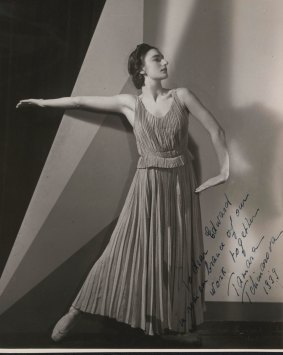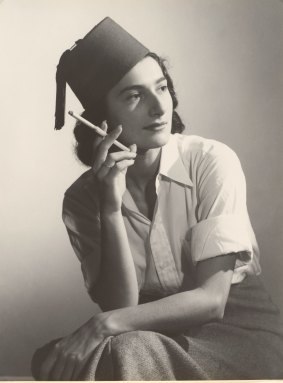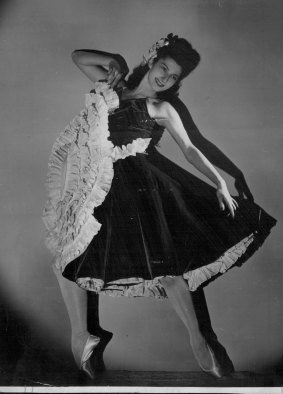This was published 6 years ago
Tamara Tchinarova ballet dancer whose life was turned upside down by Vivien Leigh
A casual conversation in Sydney between two actors, one famous, the other on the brink of fame, changed everything for the ballet dancer, Tamara Tchinarova.
Her life in Australia came to an end when Sir Laurence Olivier and his wife, Vivien Leigh, were on tour in Australia with the Old Vic.

Tamara Tchinarova in Les Presages
Invited to a performance of Moliere's play, The Imaginary Invalid, they saw Tchinarova's husband, Peter Finch, perform the lead role.
Olivier was impressed. He told Finch "If you ever come to London, look me up". Leigh was also excited, telling Tchinarova "you bring that clever husband of yours to London. You must promise".

Portrait of Tamara Tchinarova, circa 1938.Credit: Max Dupain, National Library of Australia
There was no turning back. By November 1948 Finch and Tchinarova were in London. Finch was soon in demand on the stage and the screen and Tchinarova's years as a principal dancer with Australian ballet companies had ended.
As she wrote in her memoir, Dancing Into the Unknown, she decided to be "completely involved in Peter's work".
Although her marriage to Finch ended in the late 1950s, she continued to call herself Tamara Tchinarova Finch until the end of her life.
After many decades living in London and eight years in Spain living with her daughter, Anita, she has died at the age of 98.

Tamara Tchinarova came to Australia with the Ballet Russes, stayed and danced leading roles with the Borovansky company. Credit: Fairfax Media
Born in Romania in 1919, Tchinarova moved to Paris with her mother, Anna, in 1926. Her father, Evsevy, was already in Paris, where he was seeking work as a journalist with a Russian newspaper whose readers were White Russian refugees.
In 1928, after her father took her to see Diaghilev's Ballets Russes in Paris, Tchinarova told her parents she wanted to be a dancer.
When her parents separated and her father left the family to live in the USSR, Tchinarova remained in Paris with her mother and trained at the studio of Olga Preobrajenska, a former ballerina of the Russian Imperial Ballet.
While she was still in her teens Tchinarova danced with companies that formed in Europe after the death of Diaghilev. She travelled with Ballets Russes de Monte Carlo, Les Ballets 1933, Colonel. W. de Basil's Ballets Russes and finally to Australia in de Basil's Monte Carlo Russian Ballet in 1936.
During that tour she was elated when the critic, Arnold Haskell, described her performance in the ballet, Les Presages, as "brilliant" and "outstanding".
Accompanied by her mother, she returned to Australia in 1938 with another de Basil troupe, the Covent Garden Russian Ballet.
At the end of the tour the two women decided to stay. Tchinarova taught at the Frances Scully School of Dancing and her mother worked at a factory, cutting and stitching women's underwear and later made costumes for ballet companies.
In 1941 Tchinarova was asked to join the Kirsova Ballet founded by Helene Kirsova, a former ballerina in de Basil's touring companies. Tchinarova was cast in principal roles in several ballets including the main role in Kirsova's production of Faust.
The following year she was engaged to Fred Breen, an Australian press photographer who joined the Air Force, trained in Canada and in July 1942 died in a bombing raid over Germany.
Tchinarova met her future husband, Peter Finch, at the Redleaf Pool in Double Bay. She was reading Gone With the Wind when he emerged from the water and sat beside her on the sand then opened his book on the life of Michelangelo. They were married at St Stephen's Anglican Church in Bellevue Hill in April 1943.
Tchinarova's home life with Finch in a Kings Cross apartment wasn't easy. He had seen war service in the Middle East but by 1944 was transferred to an entertainment unit in Pagewood, Sydney, where he wrote and performed for the Australian Army Amenities Concert Party. Finch brought his army mates home for all night parties and spent much of his time at the open-all-hours Sydney Journalists Club.
Tchinarova needed more in her life than waiting for her husband to come home. In 1944 she wrote a letter to Edouard Borovansky, the founder of the Borovansky Ballet, to wish him well with his next season, adding "If you ever need a dancer, think of me". At the time he did need a dancer as one of his principals was injured. Borovansky sent a cable to J C Williamson, the firm that managed the Borovansky Ballet: "Essential engage Tchinarova immediately". The firm agreed and Tchinarova accepted.
Borovansky had another reason for taking Tchinarova into his company. She had danced with him in de Basil's tours and he knew she could help him stage the ballets from those days. Borovansky maintained he remembered them all. Tchinarova soon discovered he didn't. He knew his roles but hardly anything else. For the payment of £10 for each revival, she helped Borovansky reproduce the ballets Le Carnaval , Scheherazade and Le Beau Danube.
After the end of a Borovansky Ballet season in 1946 Tchinarova danced in two musicals, Dancing Years and Gay Rosalinda, then, in 1948, left for London with Finch. Their daughter, Anita, was born in 1949.
Finch's career as an actor took flight in London and Hollywood but his affair with Vivien Leigh meant an end to his marriage to Tchinarova. Tchinarova discovered the affair when she travelled from London to Los Angeles to be with Finch who was filming in Hollywood with Leigh in the movie, Elephant Walk. When Tchinarova arrived she found Leigh was living in the same house as Finch and had organised a welcome dinner party for Tchinarova.
The party went horribly wrong. The 70 guests, mainly directors and actors, included Elia Kazan and the British actors, David Niven and Stewart Granger.
Leigh didn't join the party. She remained in her bed upstairs, trying, without success, to call her husband, Olivier, who was in Italy. She was sobbing so loudly she could be heard by the guests.
Finch ran up and down to her room to check on Leigh's condition until she made a melodramatic entry, running down the stairs in tears as she cried and called out Olivier's name.
Leigh, who was suffering from bipolar disorder, went back to England and was replaced in the movie by Elizabeth Taylor.
Tchinarova and Finch separated in 1956 and were divorced in 1959.
Finch, who married two more times, died of a heart attack in the lobby of the Beverly Hills Hotel in 1977, a year after starring in the film, Network, known for the catchline "I'm as mad as hell and I'm not going to take this anymore".
Tchinarova maintained her connections with Australia and exchanged letters with Borovansky. In 1958, a year before his death, Borovansky visited her at home and gave her one of his self-portraits as a gift. His painting remained on a wall in her London home for decades.
In the early 1960s Tchinarova began a career as an interpreter, first at a British Trade Fair in Moscow then for various dance companies, including the Australian Ballet when it toured to Russia.
In 2004 she moved to Spain to live with Anita and Anita's husband. In her memoir, Tchinarova wrote: "Magic and heartbreak are part of my background".
The magic, evident every time she stepped on the stage, will be remembered by those lucky enough to see her in her prime.
She is survived by her daughter Anita and son-in-law, Val Harrison.
Valerie Lawson